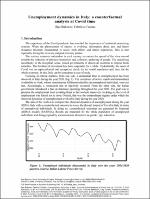Chapter Unemployment dynamics in Italy: a counterfactual analysis at Covid time
| dc.contributor.author | Bakurov, Illya | |
| dc.contributor.author | Culotta, Fabrizio | |
| dc.date.accessioned | 2022-06-01T12:21:19Z | |
| dc.date.available | 2022-06-01T12:21:19Z | |
| dc.date.issued | 2021 | |
| dc.identifier | ONIX_20220601_9788855184618_569 | |
| dc.identifier.issn | 2704-5846 | |
| dc.identifier.uri | https://library.oapen.org/handle/20.500.12657/56384 | |
| dc.description.abstract | This work performs a counterfactual analysis on unemployment dynamics in Italy during the year 2020. In doing so, ARIMA models are estimated and used to make projections for the 2020 quarters. This exercise is performed at population level and for each gender, age and educational groups. Data are from the Italian Labor Force Survey covering the years 2015-2019 at quarterly frequency. Over the quarters of the year 2020, i.e. a time period covered by the Covid-19 pandemic and related restrictions, actual and counterfactual unemployment dynamics are compared. Overall, this work tries to answer to the following question: what would have happened to unemployment dynamics if Covid-19 pandemic and related restrictions would not arise as they did? Results can be informative to policymakers if the ARIMA projections can represent a reference for the aftermath of the pandemic. | |
| dc.language | English | |
| dc.relation.ispartofseries | Proceedings e report | |
| dc.subject.other | Covid-19 | |
| dc.subject.other | Italy | |
| dc.subject.other | Unemployment Dynamics | |
| dc.subject.other | Counterfactual Analysis | |
| dc.subject.other | ARIMA | |
| dc.title | Chapter Unemployment dynamics in Italy: a counterfactual analysis at Covid time | |
| dc.type | chapter | |
| oapen.identifier.doi | 10.36253/978-88-5518-461-8.40 | |
| oapen.relation.isPublishedBy | bf65d21a-78e5-4ba2-983a-dbfa90962870 | |
| oapen.relation.isbn | 9788855184618 | |
| oapen.series.number | 132 | |
| oapen.pages | 6 | |
| oapen.place.publication | Florence |

